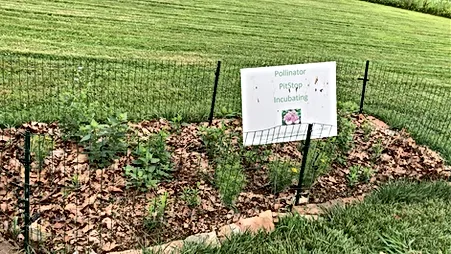
01 Jul Our Growth and Blooms
Our West Vincent Pollinator Pitstop Demonstration Garden at Evans Park is doing well! The baby plants are growing and healthy. A few have attempted flowering! The 2’ leaf layer we placed last November has shrunk down to only a couple of inches thick, still nourishing the soil and acting as an attractive, weed-reducing mulch.
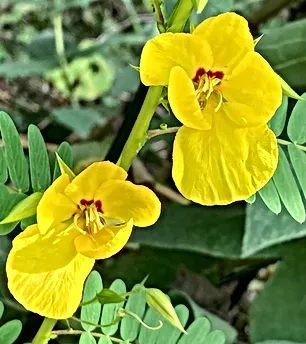
With native plants, patience is necessary – not something our culture is used to. A plant purchased at a Lowe’s will look great and bloom all summer – no waiting required. However, that plant was probably grown with chemical fertilizers and pesticides that will harm soil and pollinators and the caterpillars our birds depend upon to feed their young.
Native perennials spend the first year building a good foundation. They concentrate on producing strong roots. The saying goes – the first year they sleep, they second year they creep, and the third year they leap! Savvy gardeners know how to plan for these three phases of growth while keeping a garden looking pretty. They may plant a couple of well-placed annuals such as marigolds to fill in the bare spaces while the natives get going. Then by year three, little weeding or maintenance is necessary in the native garden.
Partridge pea (pictured) is an example of a native annual that quickly fills in bare spaces with striking yellow blooms – no patience required! The West Vincent Elementary School students each planted a seed for a plant to take home at their Earth Day celebration this year, and the West Vincent Environmental Advisory Council gave them to children during their seed ball activity at Community Day. Partridge pea supports pollinators and is a caterpillar host plant.
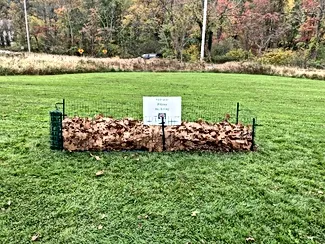
The West Vincent Pollinator Pitstop Program was designed by the West Vincent Environmental Advisory Council to blanket our township in native flowers. The goal is to provide residents with free and low-cost native plants that benefit our pollinators and birds and beautify our world.
Along the way, we hope to learn together about biodiversity, how to have less lawn to mow, how to fix wet areas, ways to keep our leaves, and, especially, the physical and mental health benefits of being in and connecting with nature and our neighbors.
The Pollinator Pitstop Program began in the fall of 2021 with the preparation of our first demonstration Pitstop Garden in Andrew Evans Park, the park in which our township building sits.
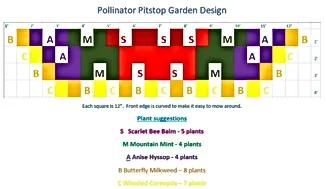
In November 2021, we held a demonstration of the easy way to convert lawn to garden – the lasagna method. We collected Amazon boxes and bagged leaves and rocks, laid out the 12’ x 4’ garden, and placed a small temporary fence around it to hold in the leaves. We then put down the cardboard, placed rocks on top to hold it down, and put about 2’ of leaves on top. We left it to sit for the winter, with a Pollinator Pitstop Hatching sign in front.
In January 2022, we held a free butterfly milkweed seed giveaway on a very cold January Saturday. We gave out plastic milk jugs to anyone who didn’t have one, and we handed out written instructions, which were also posted on our webpage with an instructional video. There was a line of cars through the township parking lot, dozens of people cold-sowing native plants for the first time!
In March, the Girl Scouts planted 650 butterfly milkweed plants, which were raised inside under ideal (for milkweed) conditions so that they would bloom the first year. These plants were given away at our Community Day in mid-May, where we also held a partridge-pea seed ball activity for the kids. EAC members wore butterfly wings – we felt really goofy, but it ended up creating great energy and being a real conversation starter! We had enough plants for our township gardener to plant them throughout our park and our Community Garden space.
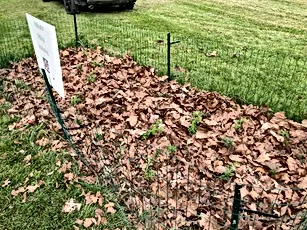
At the end of May, after the soil had warmed up, we finally planted the Pitstop Demonstration Garden. Several families had purchased the full complement of Pitstop Garden plants through the Ludwig’s Corner Horse Show Assoc., so they followed along and planted a similar garden at home.
Our lasagna method had worked perfectly! The grass had died, the cardboard was completely gone, and there were just enough leaves left to serve as a pretty mulch.
The 4’ x 12’ design had been selected to be easy to reach into from the front to weed. The planting was quick and easy, as the soil under the “lasagna” was light and easy to dig in.
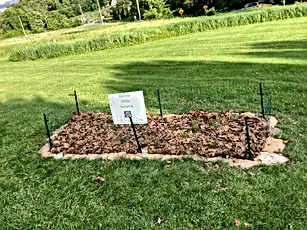
The final step of the garden preparation was to lay down flat stones, with landscape fabric underneath, so it would be easy for the Public Works Department to mow around it.
Many people showed up for the planting – some of them first time gardeners! So far, we have 179 households participating in this program. We are all gardening together and learning together. Some of our goals for next year are to add spring and fall nectar sources, trees, and shrubs, and to demonstrate plants with deep roots for stormwater maintenance.
We feel that our community has been enriched by this program.



